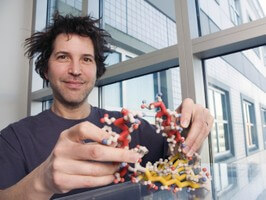International cooperation resulted in the development of an innovative and efficient method that provides rapid decoding of the protein structure in several cases where previous methods failed

The structures of many protein molecules still remain undeciphered, even after experts in the field have used a comprehensive set of different approaches. International cooperation resulted in the development of an innovative and efficient method which provides rapid decoding of the protein structure in several cases where previous methods failed.
The research findings were published in the prestigious scientific journal Nature.
The molecular structure of the protein dictates its activity. In biomedical and medical research, for example, scientists are interested in knowing the exact molecular structure of defined proteins for several reasons, some of which are:
in order to develop new drugs that can act selectively, at the molecular level, in defined biochemical reactions in the body;
In order to understand the effect of unhealthy proteins on diseases in the body, such as those associated with cancer and neurodegenerative disorders such as Alzheimer's, and how they disrupt healthy activity;
in order to learn and know what the structure and activity of viruses and bacteria are that cause inflammations and diseases;
In order to understand how the chains of amino acids, coded according to the DNA in the genes, fold and twist to obtain healthy and unhealthy protein molecule structures;
in order to develop new proteins that are not found in nature, such as original enzymes designed to speed up a slow biochemical reaction;
in order to find ways to replace dysfunctional molecular parts within proteins essential for health;
In order to develop nanometric tools, such as molecular motors.
"The innovative and important method described in the article emphasizes the contribution of computational modeling that helps scientists determine the structures and activity of molecules that are challenging and even impossible to examine with current methods," said Dr. Peter Preusch, supervisor of structural biology research grants at the US National Institutes of Health (NIH). "Expanding the collection of known protein structures - a key goal of the institutes' protein structure initiative - will be of great benefit to scientists who aspire to develop new medical substances to treat diseases."
The methods developed by the group of researchers overcome some of the limitations of X-ray crystallography in determining the molecular structure of a protein. With this method, information is obtained about the exact positions of the atoms, the chemical bonds, the electron density and other characteristics within the protein molecule. This information is collected by exposing the protein crystals to X-ray beams and scattering these beams out in a variety of directions. Measuring the angles and intensities of these diffracted beams allows scientists to build a XNUMXD model of the protein. However, it is possible that part of the information about the molecular structure will be lost during the measurements in light of limitations imposed by the laws of physics. Scientists try to avoid this problem by comparing the crystallography results to previously determined protein structures similar to the unknown structure. This method, in which "the missing spaces are filled", is called "molecular replacement".
Molecular replacement has its limitations in describing the electron density maps obtained by X-ray crystallography, the authors of the article note. Other methods have their own unique limitations.
The researchers showed that these limitations can be significantly reduced by combining computational algorithms for modeling protein structures together with those obtained from determining the structure by X-ray crystallography.
A few years ago researchers from the University of Washington developed a protein structure prediction method known as "Rosetta". The software receives a chain of amino acids - the building blocks of the protein that are all stretched in a row - and "searches" for the lowest possible energy configuration following folding, twisting and arranging the chain into a three-dimensional molecule.
The researchers found that even very low quality electron density maps obtained from the molecular replacement solutions can be useful. These maps are able to direct the search of the structure predictions of the software (Rosetta) based on the energy optimization. By using these predictive models and searching for a match to the electron density information obtained from X-ray crystallography, new maps can be produced. In the next step, these maps are processed by another method (automatic chain tracing) to obtain XNUMXD models of protein structures.
In order to test the effectiveness of their innovative integrated method, the researchers examined 13 collections of information derived from X-ray crystallography about molecules whose structure has not yet been deciphered by existing methods. The new method was able to produce structures with high separation quality for 8 out of 13 of these particularly challenging models.
"The results demonstrate that structural prediction methods, such as the Rosetta software, may be even more effective if they are combined with information from X-ray crystallography," the researchers explain. Our method, the researchers point out, requires the use of considerable computational power, up to a few thousand model predictions in the Rosetta software for each and every structure. The researchers developed an automatic procedure that could reduce the number of options and reduce the number of times required to rebuild the model for corrections - a procedure that could significantly reduce the calculation time.
The general public is called upon to donate their unused home computing time (for example, at night or at work) in order to assist in the joint effort to determine the structure of proteins of biological and medical importance (see the scientific project known as "fold it" - http://fold .it/portal/).

One response
The kind of thing you wonder "how come they didn't think of this before" when you read about it.